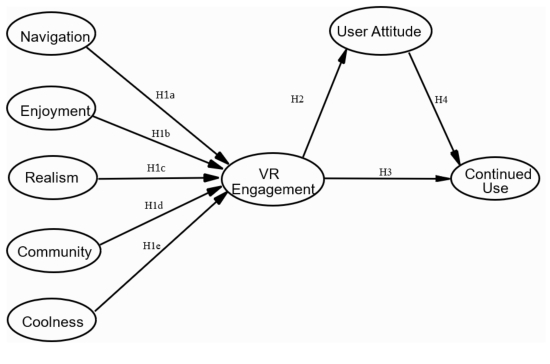[This short press release from North Carolina State University describes a new study that applied the uses and gratifications approach to understand what leads to consumer engagement with and interest in continued use of 360 degree videos, and they found key roles for realism and enjoyment. Quoting the abstract, the study
“found that five types of gratification, including utilitarian (i.e., navigation), hedonic (i.e., enjoyment), sensual (i.e., realism), social (i.e., community), and symbolic (i.e., coolness), significantly motivated users to use such immersive videos. Simultaneously, data demonstrated that these five types of gratification could influence users’ cognitive engagement with virtual content. In addition, such VR engagement facilitated users’ positive attitudes toward immersive videos and continued usage of them.”
Follow the link below to read the open-access publication. –Matthew]

[Image: Figure 1, a chart illustrating the conceptual model, from “Shared Virtual Reality Experiences during the COVID-19 Pan-demic: Exploring the Gratifications and Effects of Engagement with Immersive Videos”]
Study Finds Realism a Key Factor in Driving Engagement with Virtual Reality Videos
By Matt Shipman
May 12, 2022
FOR IMMEDIATE RELEASE
Yang Cheng ycheng20@ncsu.edu
Matt Shipman matt_shipman@ncsu.edu
A recent study finds that realism is a key factor in determining whether viewers engage with virtual reality (VR) videos – and that engagement is itself a key factor in determining whether viewers are interested in watching VR videos in the future.
The researchers focused on VR videos that offer a 360-degree view of a given scene that viewers can navigate on conventional video screens; VR headsets were not required.
For the study, researchers surveyed 1,422 study participants located in the United States, all of whom had previous experience with virtual reality videos. Participants were asked a series of questions designed to explore both which factors drew them to VR videos and what elements of the videos increased viewer engagement.
“We found there were two aspects of virtual reality videos that were the most powerful predictors of whether viewers enjoyed VR videos and engaged with their content,” says Yang Cheng, first author of the study and an associate professor of communication at North Carolina State University. “Specifically, we found that realism and enjoyment were the key variables here. Another variable that contributed to user engagement was whether the VR videos were part of an interactive platform that allowed users to establish a sense of community.
“Our study is the first to identify that realism in these videos is a key variable in driving viewer engagement,” Cheng says. “And the more engaged viewers were, the more likely they were to want to view additional VR videos in the future.”
The researchers note that their findings can be used by video developers to improve user engagement and encourage continued use of immersive videos.
The paper, “Shared Virtual Reality Experiences during the COVID-19 Pandemic: Exploring the Gratifications and Effects of Engagement with Immersive Videos,” is open access and appears in the International Journal of Environmental Research and Public Health. The paper was co-authored by Yuan Wang of the City University of Hong Kong and by Wen Zhao of Fairfield University.
|